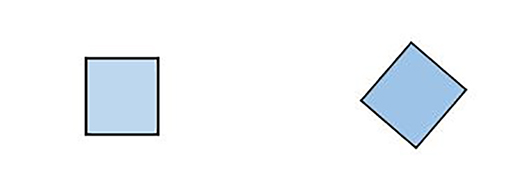Thinking holistically
In their early school years, learners have typically been presented with shapes and they have learned their names (Figure 1). However, they will also have learned some implicit things about these shapes. One of these is orientation or ‘right way up-ness’.
It is common for children in early years schooling to be presented with shapes which are upright, in the case of squares and rectangles, and for triangles to sit on a horizontal base. So, quite often, learners decide that the orientation of the shapes is an important property and do not accept shapes in orientations which are unusual. As an example of this, consider the two squares in Figure 2 below, which are presented in different orientations.
It is common for the first of these two shapes to be perceived as a square, whereas the second shape is perceived as a ‘diamond’ because it sits on its corner.
One way of dealing with this is to suggest that the learner turns the paper round, so that they can see the shape ‘the right way up’. This is more difficult if the shape cannot be turned round, but the suggestion can be to turn the head so as to look at the shape ‘the right way up’.


